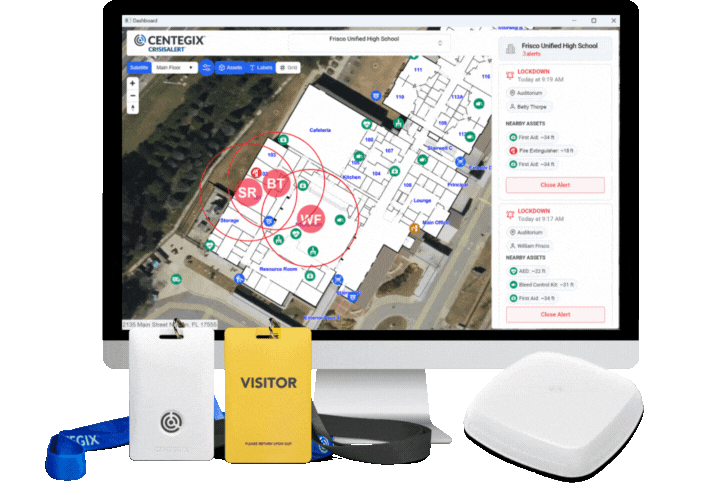Education, healthcare, and government are fundamental to thriving communities, meaning community leaders must nurture a culture of safety for development and progress. With a nationwide increase in violence in healthcare, schools, and government buildings, leaders have new challenges to keeping their communities safe.
Thankfully, advancements in safety technology now offer the possibility of shaping a safer future for our schools, healthcare systems, and local government, enabling leaders to provide:
- Greater safety
- Faster response times in emergencies
- Efficient emergency communication
Reinforcing Safe Schools
Schools are the training grounds for every community’s future leaders. Protecting schools is an investment in your community’s future.
Research shows students are more likely to take an active role in learning and demonstrate better academic performance when they feel secure and safe in their learning environment. A school that prioritizes safety will see better attendance, improved academic achievement, and decreased instances of truancy.
The Research Alliance for New York City Schools found student academic improvement was more closely related to perceptions of school safety than the other three pillars: professional development, high academic expectations, and teacher collaboration.
Students are more likely to think of their campus as a safe space if they know all guests who enter campus are verified. CENTEGIX’s visitor management streamlines visitor screenings and authorization with electronic check-in terminals. The Enhanced Visitor Management feature provides campus guests with visitor badges, collecting real-time visitor location data which gives your staff insight into who is in your building at all times.
Your students are also more likely to perceive your campus as safe if they are confident help will arrive quickly during school emergencies. Wearable safety badges give educators discreet ways to request emergency help with real-time location data. Teachers and support staff can signal when they need help with things like medical issues and fights, or they can initiate a campus-wide response for more significant crises.
Dynamic mapping solutions can integrate visitor management systems, wearable badges, and existing safety and security infrastructure to aid administrators and first responders in reacting to problems as they occur, saving valuable seconds in response time.

Reducing Workplace Violence in Healthcare Facilities
Healthcare safety is especially complex because of the volume of patients and visitors constantly moving in and out of the facilities. Add to that the doctors, nurses, and extensive support staff most healthcare settings require.
The culture of safety in these facilities is paramount to patient care and community engagement. Healthcare facilities tend to impact large swaths of their surrounding communities, making campus and community safety even more important for healthcare decision-makers. The reality is, if people don’t feel safe at your healthcare facility, they are more likely to delay or defer care until their conditions are severe.
Creating a culture of safety is becoming increasingly important for healthcare workers as well. Increasing incidents of violence in healthcare environments have contributed to decreased workplace performance and higher turnover in recent years.
Instances of workplace violence are rising in all industries coming out of COVID-19 lockdowns, but healthcare workers make up 50 percent of workplace violence victims. More than 45 percent of emergency doctors have experienced violence on the job, and 70 percent of nurses reported having been assaulted at work, with nurses, in particular, seeing a 30 percent increase in violence incidents perpetrated against them since the height of the COVID-19 pandemic.
Overall, 73 percent of healthcare staff have experienced a workplace violence incident in the last year, 25 percent of critical healthcare staff reported a willingness to quit over violence in healthcare workplaces, and 48 percent of respondents said on-the-job violence decreased their motivation and satisfaction.
Like with education, the vulnerability of patients in healthcare settings requires your on-campus and community emergency planners to act with speed, precision, and effective communication during emergencies.
Innovations in wearable technology grant healthcare workers the power to alert an emergency with the simplicity of a single button, whether an act of patient aggression that needs quick assistance or a facility-wide emergency requiring a universal response.
A silent, wearable duress button with precise location data allows administrators and safety personnel to respond to crises quickly and discreetly before they affect the rest of the campus population.
Alongside the wearable duress buttons for healthcare staff, an enhanced visitor management system gives administrators control over guest authorizations and locations. These visitor tools keep guests from wandering into hazardous areas while protecting your staff and patients from unwanted guests and interruption—promoting fluid, secure operations.
Most importantly for healthcare administrators, an increased sense of safety leads to better patient health outcomes, which is the ultimate goal of every healthcare provider. According to the World Health Organization’s (WHO) Global Action on Patient Safety report, “Investing in patient safety positively impacts health outcomes, reduces costs related to patient harm, improves system efficiency, and helps in reassuring communities and restoring their trust in health care systems.”
Maintain Government Staff and Campus Safety
Government buildings are where the day-to-day work of creating safer, stronger communities happens. It’s the vital groundwork on which most community safety infrastructure lies.
No matter how safe our spaces are, emergencies happen. Medical problems can escalate in an instant, and violence can materialize unexpectedly.
Government workers devote their lives to protecting us, whether law enforcement, code enforcement, policymakers, or community organizers. Equipping them with visitor management, alert badges, and modernized safety planning will ensure a safer workplace from which to build stronger communities.
“Our local school district chose CrisisAlert to protect its staff and students and we appreciate the implementation with CENTEGIX. Alert data comes to us through our existing inbound process and does not require any additional software in our PSAP [public-safety answering point], which makes it easy to implement the solution for our staff.”- Christina Mortimer, Director of Communications, Flagler County Sheriff’s Office, FL
Building Safer Communities Starts with a Multi-Layered Safety Approach
There are endless strategies and vendors to help tackle individual campus safety issues. Still, a multi-layered approach is the best way to build a culture of safety in your community.
The most effective safety strategies account for the entire community and employ a system of interconnected and complementary layers.
A multi-layered approach to technology, planning, and response procedures results in a highly responsive and flexible safety network.
A multi-layered technology network includes:
- Wearable alert badges
- Visitor management system
- Real-time visitor management technology
- Interactive digital building and asset mapping
- Efficient reunification
By combining multiple approaches to campus safety, you have an awareness of who is there and why, you reduce incident response time, and you ensure that the crisis can be located precisely and immediately when it occurs.
The people around your campus and in the communities you serve are just as affected by your safety approach as your staff, patients, and students. Beyond reducing on-campus instances of violence in healthcare and education, robust safety infrastructure builds confidence in your patients, staff, and the community at large.
The CENTEGIX Safety Platform™ was built to decrease emergency response time at each stage of the process:
Crisis Identification
Crisis identification is the first step, and using a badge-based silent alert solution like CrisisAlert™ empowers everyone on your campus, reducing the time it takes for a crisis or emergency to be identified and saving valuable minutes for first responders.
CrisisAlert badges give staff the ability to discreetly, quickly, and easily indicate an emergency or trigger a silent alert. This tool increases safety at the individual level while empowering each staff member to act as a security monitor, identify incidents, and trigger an immediate response through a multi-press button on their badge. Since it operates on a private, managed network, there are no coverage gaps and no Wi-Fi or cellular data dependency.
Security Personnel Notification
In campus-wide emergency response situations, mobile alert and real-time location data monitoring systems like CrisisAlert reduce the time it takes to communicate with administrators, security staff, first responders, and other pertinent parties on site.
Systems that employ audio and visual emergency notifications aid in directing everyone to follow safety procedures while providing emergency responders with the incident and location data they need to deliver the appropriate response to the correct location, fast.
CENTEGIX’s Safety Platform integrates with local emergency responders and automates notifications to reduce the delays and human errors often caused by manual communications.
Response Time
Typically, the actual arrival of emergency response personnel is the timeliest yet most time-consuming step in an emergency response. With a badge system like CrisisAlert, responders can be notified in real-time, saving valuable time in their response.
Integrated with intelligent mapping technology like Safety Blueprint™, CrisisAlert shows responders where help is needed and displays all the area’s relevant safety and security assets. This eliminates the time it takes to search for resources like AEDs or fire suppression systems. Local law enforcement and first responders can immediately take action to neutralize any crisis situation.
Do You Need a Community Safety Partner?
CENTEGIX partners with communities to provide comprehensive safety solutions that increase safety, plan for emergency events, and reduce response times if an emergency occurs.











